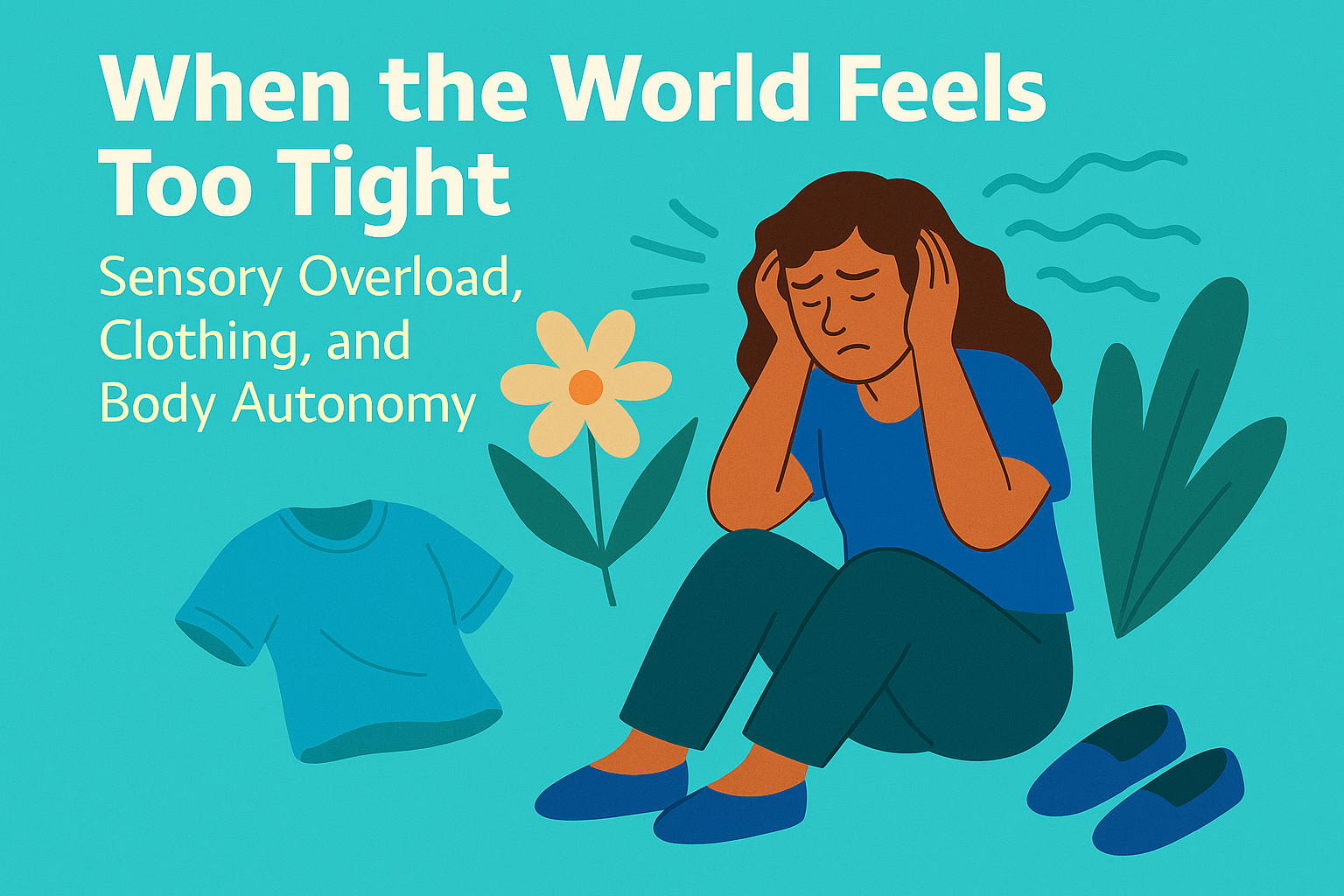When the World Feels Too Tight: Sensory Overload, Clothing, and Body Autonomy
Today started with a pounding headache.
The kind that makes light feel like daggers and every sound like an alarm. Add in the scratch of a tag on my shirt and the hum of the fridge, and it feels like the world is literally pressing in.
For some people, putting on a pair of jeans feels like slipping into a second skin.
For others, it feels like a full-body trap.
If you’re someone who’s ever been irritated to tears by a tag, overwhelmed by the noise of a grocery store, or completely thrown off by a waistband that just won’t sit right, this one’s for you.
Whether you’re neurodivergent, chronically ill, highly sensitive, or simply human in a world that never stops buzzing, this is about reclaiming body autonomy when the sensory volume is stuck on high.
Sensory Overload Isn’t Just “Being Dramatic”
Let’s clear something up: sensory overwhelm is real. It’s not about being picky or overreacting. It’s about the body’s nervous system going into overdrive, processing too much input from too many directions at once. For many neurodivergent folks (especially those with autism, ADHD, OCD, and anxiety), this is a daily experience.
The texture of a sweater, the scratch of a seam, the flicker of fluorescent lights, the low hum of conversation, even the subtle tightness of elastic around your waist—any one of these can make it feel like the world is pressing in too hard. Combine a few (especially with a headache in the mix), and it’s like trying to breathe through a too-small straw.
Clothing: The First Boundary We Feel
Clothing is supposed to protect us, but for people with sensory sensitivity, it often feels like a source of threat. It presses against the skin, sends conflicting messages to the brain, and becomes an inescapable irritant.
Common culprits:
-
Tight waistbands that dig in
-
Scratchy tags and seams
-
Synthetic fabrics that don’t breathe
-
Bras, shapewear, underwear, or anything restrictive
-
Socks with noticeable toe seams
The problem isn’t just physical, it’s psychological. When your clothes are causing distress, they become a silent source of stress all day long. And because society often expects us to “just deal with it,” we rarely question the toll this takes.
What Body Autonomy Really Means Here
Body autonomy isn’t just about big life choices. It’s also about the small ones: what we wear, what touches our skin, when we get to say “no more.”
For people navigating sensory overwhelm, reclaiming body autonomy means:
-
Choosing comfort over fashion, always
-
Dressing for how you feel, not how you think you’re supposed to look
-
Giving yourself permission to change clothes (or remove them entirely) when your body says it’s time
-
Saying no to social expectations that hurt your nervous system
It’s not selfish or lazy. It’s self-protection. And it matters.
Small Tools for Big Relief
You don’t need a total lifestyle overhaul to reclaim comfort. Here are some small, practical ways to build a more sensory-friendly world around you:
-
Tagless, Seamless, Soft
Seek out clothing made with soft natural fibers (cotton, bamboo, modal). Cut out tags. Choose seamless styles. Test textures with your hands before buying when possible. -
Have a “Safe Outfit”
Keep one go-to outfit that feels like a hug. On bad days, this is your uniform. Zero shame, all safety. -
Strip Down at Home
If being nude or partially clothed feels like relief, go for it. Your home is your sanctuary. Less fabric means fewer sensory triggers. -
Layer Strategically
Use soft base layers (like camisoles or bike shorts) to create a barrier between skin and rougher fabrics. -
Sound + Light Buffers
Noise-canceling headphones, tinted glasses, dim lighting, and even weighted blankets can help regulate your system. Sensory tools are not toys—they’re tools. -
Build Exit Plans
Overstimulating environments happen. Give yourself permission to leave early, take breaks, or sit in the car with the A/C blasting if needed.
Your Body Isn’t the Problem. The World’s Just Loud.
The goal isn’t to make your body fit the world. It’s to build a world that’s kinder to your body. That might mean dressing in ways that feel odd to others, stepping out of loud rooms, or refusing to wear something that spikes your anxiety.
It’s not weakness. It’s wisdom.
So if the world feels too tight—especially on days when headaches or sensory overload hit hard—loosen your waistband, turn down the noise, and let your body call the shots.
You’re not broken. You’re just sensitive.
And that’s not only valid—it’s powerful.

